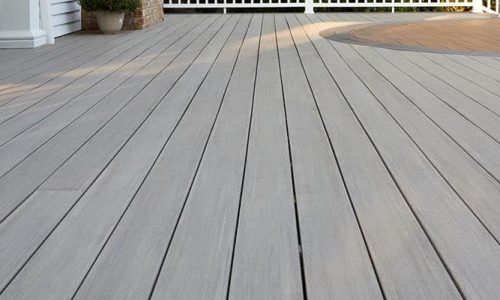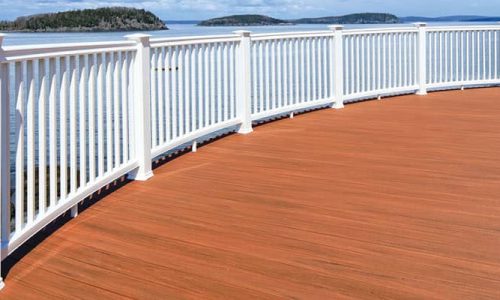Deck maintenance is vital to a deck’s appearance and structural integrity. When done properly and routinely, it increases your deck’s lifespan and reduces the likelihood of future repairs or replacements. In brief, deck maintenance protects your outdoor living space investment.
Ultimately, your deck’s maintenance needs depend on its material composition. Ensure your deck stays safe and beautiful for years to come with these deck maintenance best practices for the most common deck materials.
1. Inspect your deck
| Frequency: | Time: | Cost: |
|---|---|---|
| Annually | 1+ hours | $0 |
Performing an annual deck inspection of the surface and substructure helps you catch issues — such as loose or rusted fasteners, moisture damage at ground contact, or joist issues — before they develop into larger (and more costly) problems that could even require a full deck replacement.
You can inspect the deck yourself and contact a professional if you have any concerns. Look for:
- Weathering and moisture damage
- Wear and tear
- Ledger board separation
- Rusted or loose fasteners
- Wood rot
- Insects
- Bowing or sagging boards
2. Clear and clean your deck
| Frequency: | Time: | Cost: |
|---|---|---|
| Annually | 1+ hours | $0-$30 |
Cleaning your deck with an appropriate cleaning solution kills mould and bacteria, and keeps your deck in great shape. If you have a wood deck, scrubbing exfoliates the wood so it better absorbs stain and/or sealer. Just be careful not to use harsh stripping agents or scrub too hard.
Be sure to follow the specific cleaning instructions for your deck material, as best practices change between materials and manufacturers. Here’s a general step-by-step overview of how to clean your deck:
- Clear the deck
- Prepare the cleaner
- Section the deck
- Clean with the proper brush
- Rinse
- Let dry for 48 hours
You can create your own cleaner out of dish soap and water for wood decks, or purchase manufacturer-approved solutions for composite decking.
TimberTech Tip:
Avoid cleaning your deck in direct sunlight, which can cause the cleaner to dry too quickly and leave a white residue.
Be sure your scrub brush is compatible with your decking, too. We recommend a stiff natural fiber brush for TimberTech’s Advanced Polymer boards, and a medium stiffness nylon brush for composite.
3. Replace damaged boards
| Frequency: | Time: | Cost: |
|---|---|---|
| As needed | 1+ hours | Approximately $6+ per board — varies by material |
If you notice any damaged boards with cracks, splinters, rot, sagging, or bowing, now’s the perfect time to replace them. Carefully inspect each board and mark those that need to be replaced with chalk or marker. If you need to replace more than a few boards, consider totally resurfacing your deck.
Once you know how many you’re replacing, you can order what you need and get ready to repair your deck. Wait until your new boards arrive so you can cut and install them on the same day. This is especially important for manufactured decking, which can contract as temperatures fluctuate and change the size of your boards.
4. Inspect and tighten fasteners
| Frequency: | Time: | Cost: |
|---|---|---|
| Annually | 25+ minutes | $0-$10 (estimated 100 deck screws) |
Take a close look at fasteners and screws as you inspect your deck, paying special attention to guardrails and ledger board attachments, to confirm nothing’s loose or deteriorating. Replace rusted or damaged fasteners, and tighten any loose connections you find. Installed lag screws should have washers, and bolts should have nuts and washers.
Test connections with a hammer strike. If you hit a metal bolt with a hammer, it will ring hollow if it’s loose and solid if it’s secure.
5. Sand and seal wood decks
| Frequency: | Time: | Cost: |
|---|---|---|
| Every 1-3 years as needed | 8+ hours | $400 annually |
Wood deck owners have an extra maintenance step and have to seal their deck every one to three years to protect the wood decking. Before adding sealer, decks need to be cleaned and sanded for best results.
Sealing a deck takes several hours and the costs add up. Over its 10-year lifespan, wood deck maintenance costs $4,000, and professional maintenance can add hundreds of dollars to the cost each year. Manufactured decking only needs a thorough inspection and clean annually, which is a benefit for homeowners interested in low-maintenance home improvement ideas.

5 maintenance tips for a stunning deck

Year-round care between annual inspections is also an important part of deck maintenance. Check out the best practices below to preserve your deck’s look and integrity.
- Regularly rearrange furniture to avoid discoloration and uneven sun fading, or invest in fade-resistant TimberTech decking.
- Trim and maintain landscaping to avoid moss, mould, and mildew growth, and excess water exposure.
- Avoid mats and rugs that can trap moisture or discolor decking unless they’re rated for outdoor deck use and moved periodically.
- Remove leaves and snow regularly to avoid moisture exposure and discoloration.
- Keep heat sources like grills and firepits off your deck — place them on a concrete patio instead.
Composite vs. wood deck maintenance

Manufactured decking was created as a low-maintenance alternative to wood, so there’s no contest about which is easier to care for. Both deck materials require regular inspections and cleaning, but wood decks also require sanding and sealing once a year.
Composite and Polymer decking also lasts longer than even the most well-cared-for wood. TimberTech composite boards last 25+ years, and our Advanced Polymer decking is guaranteed for 50+ years.
Wood decks last 10+ years with consistent maintenance, though it varies by wood species and deck location.
| Composite and PVC | Wood |
|---|---|
| • Annual inspection • Annual cleaning • Lifespan: 25+ years | • Annual inspection • Annual cleaning • Annual sanding • Annual sealing • Lifespan: 10+ years |
Deck maintenance preserves the appearance and integrity of your deck, and it’s an important part of every deck owner’s annual routine. If you’re looking to save time and money while caring for your deck, consider low-maintenance composite decking that doesn’t require any sanding or sealer.





